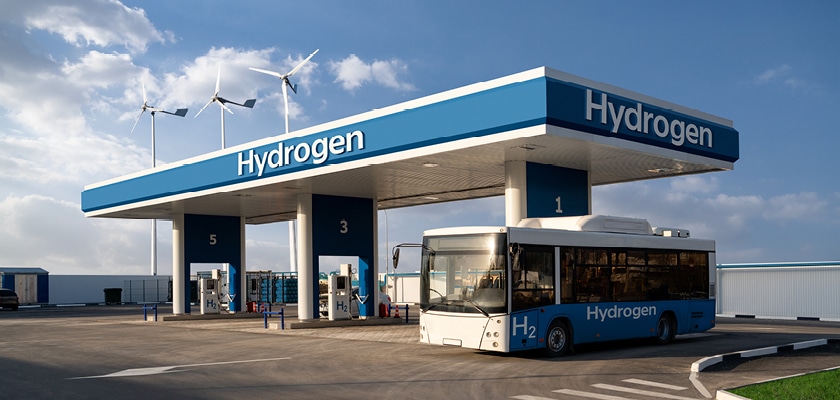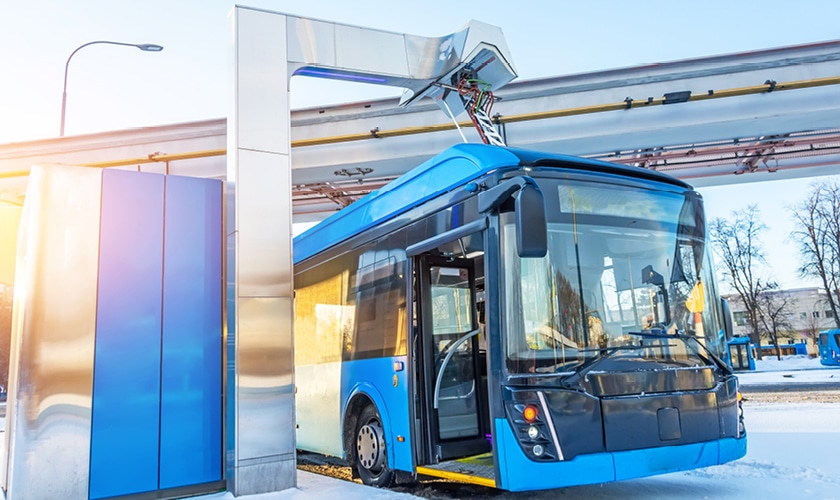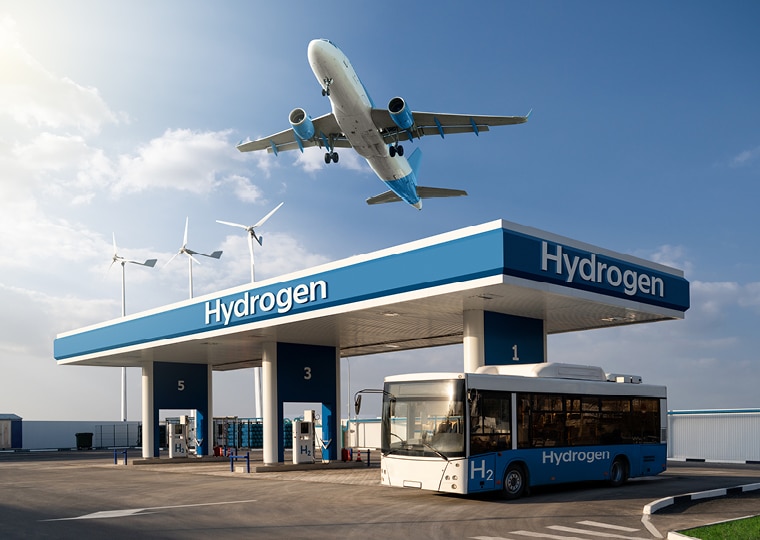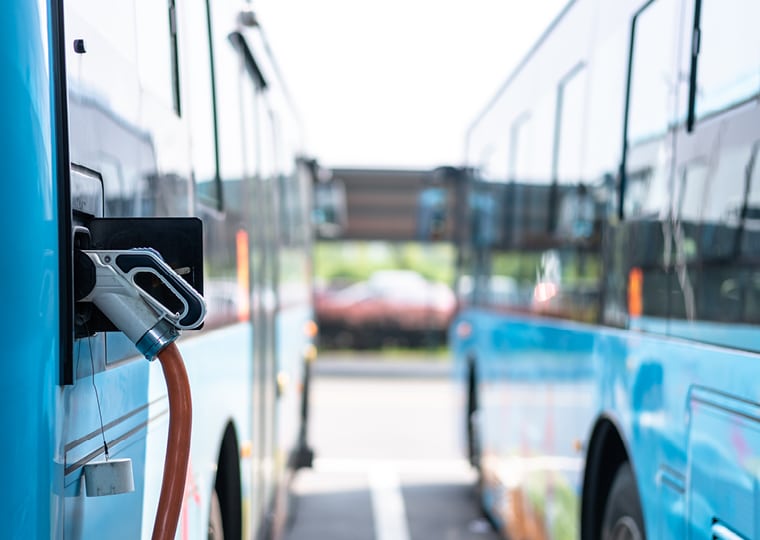
The need to create an affordable and equitable clean transportation system has emerged as one of the Biden-Harris Administration’s key priorities. This initiative was further advanced earlier this year when the U.S. departments of Energy, Transportation, Housing and Urban Development, jointly released the historic National Blueprint for Transportation Decarbonization, which lays out the framework of strategies and actions to remove all greenhouse gas emissions from the nation’s transportation sector – which currently accounts for a third of all domestic greenhouse gas emissions – by 2050.
For more than five years, STV has been an industry leader in supporting the development of decarbonized transportation infrastructure, from holistic zero-emissions bus fleet transformation to facility-focused projects like bus depots maintenance facilities. This practice has been further augmented in recent months with the addition of industry experts like Dan Corey, P.E., vice president and director of mobility technologies, and Craig Cipriano, senior vice president and national director of zero-emissions mobility.
In this roundtable discussion, Corey and Cipriano are joined by Sam Hrvacic, vice president and senior engineering operations manager; Michael Broe, senior engineering operations manager; Lauren Alger, P.E., ENV SP, sustainability manager; and Faye Farahmand, P.E., zero-emission facilities engineering lead. Together, these thought leaders will discuss some of the challenges and milestones of the Biden-Harris Administration’s decarbonization blueprint, as well as how STV’s team is best suited to support clients as they navigate this unprecedented investment in a cleaner transportation system.
Has there been a touchstone moment or “turning point” that has led to this current focus on decarbonization in our transportation sector?
Faye Farahmand: The onset of this movement came in 2018 when the California Air Resource Board (CARB) mandated that all transit agencies in the state be 100% zero-emission by 2040. Following that mandate, all large transit agencies were required to submit their zero-emission transition rollout plans by June 2020. Now, some of those agencies are in the process of procuring their first zero-emission buses later this year. These are in addition to the transit agencies that have already started running zero emission buses with either hydrogen fuel-cell or battery powered propulsion systems in California.
Sam Hrvacic: While states like California paved the road for zero-emission adoption, the passage of the Infrastructure Investment and Jobs Act (IIJA) in 2021 accelerated this movement on a broader, national level. This bill mandated that all transportation across the country will transition net zero-emissions by 2050. Between the amount of money that was being earmarked for this effort, and the mandate itself, what was once viewed as a hypothetical concept had been transformed into a reality.

Where in the country are we currently seeing the most advanced efforts to decarbonize and reduce greenhouse gas emissions within transportation?
Michael Broe: As Faye mentioned, California was the first state to enact legislation related to zero-emissions. In kind, STV and our partners have been working with the Los Angeles County Metropolitan Transportation Authority (Metro), the largest transit agency in the state of California, for the past five years, supporting their efforts to develop zero-emission transition plans. That includes developing a master plan, procuring vehicles, and designing the infrastructure the agency needs. Los Angeles’s goals for zero-emission transformation are more aggressive than the rest of the state, and they plan to reach this milestone by 2030 rather than 2040. Our work for Metro opened the doors for STV in other parts of the state, including San Diego County, and San Francisco.
Lauren Alger: Access to more funding for decarbonization is really driving a lot of efforts forward. In addition to the IIJA, the Inflation Reduction Act of 2022 set aside approximately $370 billion for energy efficiency and climate initiatives. This legislation is investing in lower embodied carbon materials. The International Energy Agency estimates that about 10 percent of all global emissions are tied to the life cycle of construction materials, such as steel, concrete, and aluminum. Creating incentives to reduce emissions tied to material production has a major impact on broader decarbonization efforts.
Where else, beyond the bus transit sector is this change advancing at a pace to meet the Biden administration’s decarbonization goals?
Craig Cipriano: STV has been at the forefront of supporting our bus transit clients in their zero-emissions mobility goals for more than five years. More recently, we’ve seen an evolution in focusing these efforts to other kinds of fleets, like paratransit and non-revenue bus vehicles, as well as municipal fleets for public school buses, fire departments, departments of sanitation, etc. In these instances, STV is taking what we learned in public bus transit and leveraging that knowledge to advance initiatives throughout the country.
Dan Corey: We’re looking at transit agencies that have fixed wheel and fixed rail routes and exploring ways to implement zero-emissions technology in the form of electric vehicles so that we can better connect underserved populations to these services. Additionally, we’re seeing a lot of growth in the port sector – both marine and airports – in terms of integrating electric and autonomous vehicles as part of their decarbonization efforts.
Sam Hrvacic: While the transit sector is focusing on vehicles and fleets, others are looking at the energy sector – namely where is the energy coming from to make those clean energy vehicles? It only makes sense that if you’re manufacturing a clean vehicle, the source of energy you use to produce that vehicle is clean and ideally renewable as well. That’s why in some cities they are looking at the decarbonization effort holistically, from source to plug, and moving away from fossil fuels or coal and turning to sources like offshore wind farms, nuclear power, etc.
Michael Broe: The U.S. Department of Energy recently released approximately $8 billion for a hydrogen hub network across the county with the idea of creating a 100% clean electrical grid by 2035. The grid itself is multifaceted, meaning it’s not just for the transportation sector, but also the power generation sector. This is a very comprehensive solution for the zero-emissions effort.

How does improving social equity intersect with the push to decarbonize?
Sam Hrvacic: Decarbonization can play a huge role in righting the wrongs of the past. Traditionally, disadvantaged communities have borne the brunt of industrialization. In many cases, the transportation network provided to these communities was inadequate in terms of functionality and availability. In these instances, decarbonization efforts can be leveraged to fix what was once left behind by prioritizing decarbonization efforts in these communities. Bringing in local clean energy initiatives leads to better-paying jobs and commutes that become far more reasonable for the daily worker.
Dan Corey: As we plan and develop new clean infrastructure, it needs to be centered around communities that have walkability and bike-ability. One of the key goals of the Biden Administration is to increase convenience in communities via the integration of multimodal hubs and more dynamic transit where there historically hasn’t been. There’s also an educational element to it. When we talk about things like autonomous vehicles or zero-emission buses, we need to explain how this benefits the communities, and improving access to schools, healthcare, commerce, etc. Once you get a community used to the idea of something, and they can see it, touch and feel, that acceptance helps turn the tide and can push a big initiative forward.

What are some of the challenges associated with the implementation of zero-emission technology, and what are some of the solutions we have provided clients to that end?
Faye Farahmand: Current technology supports two options for zero-emission vehicles, battery-electric and hydrogen fuel cell-electric vehicles. Each of the options has distinct advantages and disadvantages. For battery-electric buses the key is how the charging infrastructure interacts with the utility companies. Utility companies are facing challenges in providing the necessary power, and in many cases need to integrate more substations. A photovoltaic solar system may provide part of the power demand. Stationary battery storage with power management system is another approach. A charging management system can keep power demand at the lowest possible. Additionally, the facility’s design, including the configuration of the charging system, in conjunction with operation plan, is another tool that could flatten the power curve and to keep the demand as low as possible.
For hydrogen fuel cell-electric vehicles there are two challenges: 1. Source of hydrogen and availability and 2. Hydrogen fueling infrastructure site features. The good news is that hydrogen production is supported by U.S. Department of Energy (USDOE). The USDOE has allocated $8 billion for creation of hydrogen hubs throughout the United States. This is in addition to other entities that are growing their hydrogen production sites. Accordingly, numerous sources of hydrogen are rapidly being implemented throughout North America.
Lauren Alger: Funding is a major constraint. Shifting towards electrification requires significant investment. STV’s grants management team has helped clients secure more than $2.8 billion in various grants, with major focus areas surrounding energy efficiency and zero-emission vehicles grant programs, as well as grants for charging infrastructure.
Craig Cipriano: STV looks at zero-emission fleet transformation with a holistic change management approach. Our comprehensive master planning services bring together principles of equity, resiliency and safety and our program management structure coordinates with several disciplines within an organization, including operations, capital planning, capital delivery, and others that serve fleet transformation.
Dan Corey: Supply chains continue to be an issue as we look to implement decarbonization efforts. Our team understands that you can’t rely on one source of supply for materials. We can help clients work with vendors so they procure products early, or partner with other clients that we’re already working with to help everyone get the products they need for their programs to succeed.

How are we as consultants partnering with transit agencies to better engage stakeholders and get their “buy-in” for this process?
Dan Corey: As part of STV’s ecosystem approach, we explain the larger benefits of turning over an entire fleet to zero emissions. That might be different for each agency, but we work closely with our clients to communicate and educate them on the process, as well as which solution is best for them.
Craig Cipriano: Something we see with some of our clients is they procure their first few zero-emission vehicles, and then they want to add the charging infrastructure, without first conducting a comprehensive master planning process at the onset of their program. Then as they increase the size of their fleets, they find it’s much harder to support a larger fleet of 50/100 electric vehicles than it is a fleet of 10. STV’s team coordinates with our clients to educate their workforce to build trust in this new technology, while also providing them with the insights for any changing business processes that will have an impact on their day-to-day operations.
Faye Farahmand: Having that master plan at the onset of a program makes a huge difference. For example, if a client invests in a hydrogen facility for a small number of vehicles, the cost per vehicle is very high compared to battery-electric, but that changes dramatically as the number of vehicles procured increases. Having a comprehensive master plan as the first step of a process before an investment is made helps to inform our clients on decisions like these.
We also help prepare energy modeling through the use of our proprietary software PEER. Utilizing this energy modeling and analysis, we enhance our study to verify the best solution for each transit agency.
How will a robust change management plan drive this effort forward and yield successful results?
Craig Cipriano: It can’t be stressed enough that zero-emission fleet transformation is about the people, specifically the people using the vehicles. Change management is about bringing people together, communicating, and setting up proper training for the workforce. It involves working with all the stakeholders, including unions, local fire departments and emergency services, et al. That’s how you develop the stakeholder support and buy-in you will need to change internal business processes – through continual communication and engagement.
Lauren Alger: Change management should be driven by a strategic master plan that is further supported by strong communication, understanding the client’s needs, and our technical engineering background. Additionally, we need to leverage data and have a robust data management component to help shape our clients’ goals and long-term plans related to decarbonization. Data analysis will inform how funding is secured and overall risk management, which will be crucial to successful change management.






